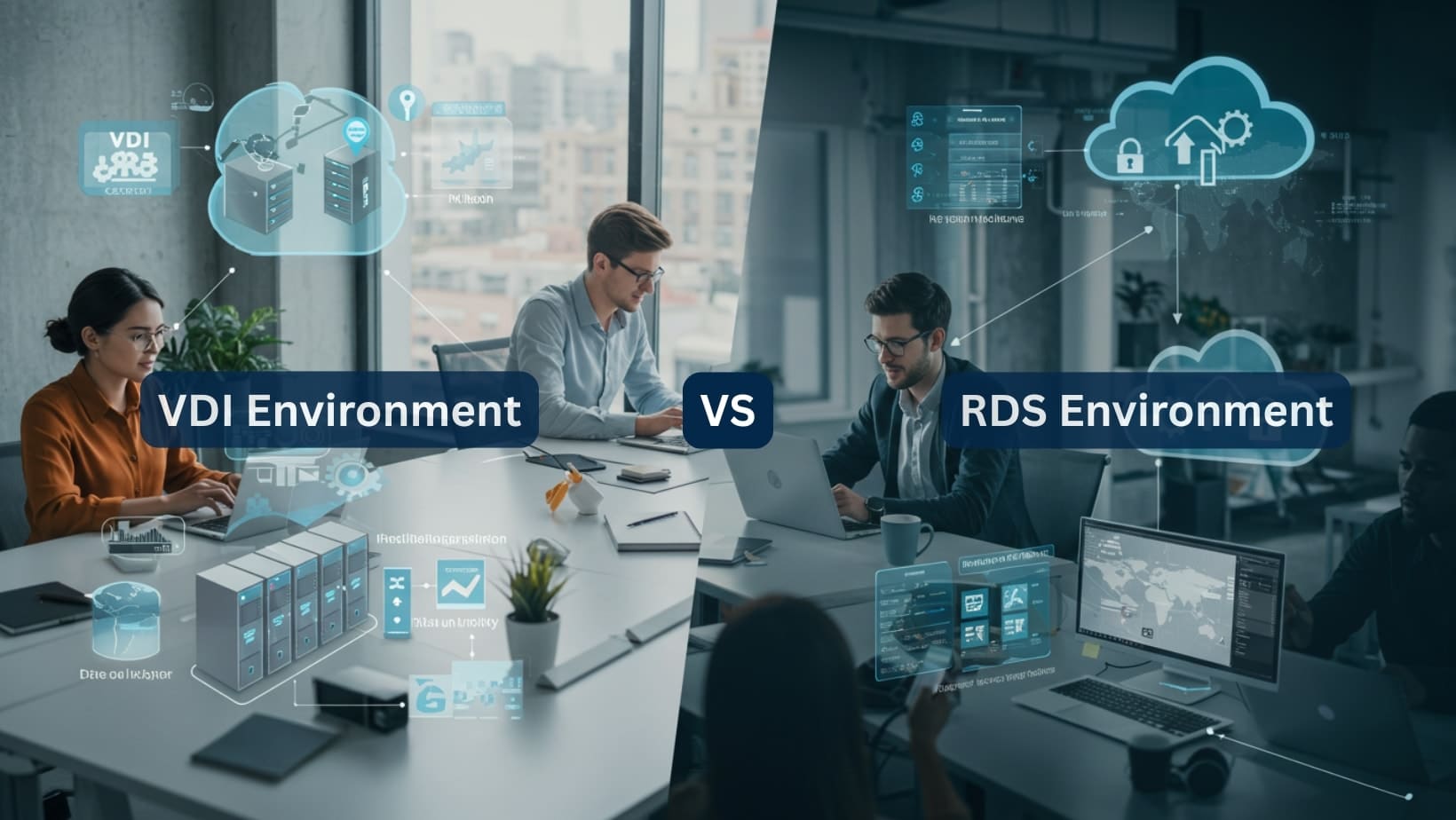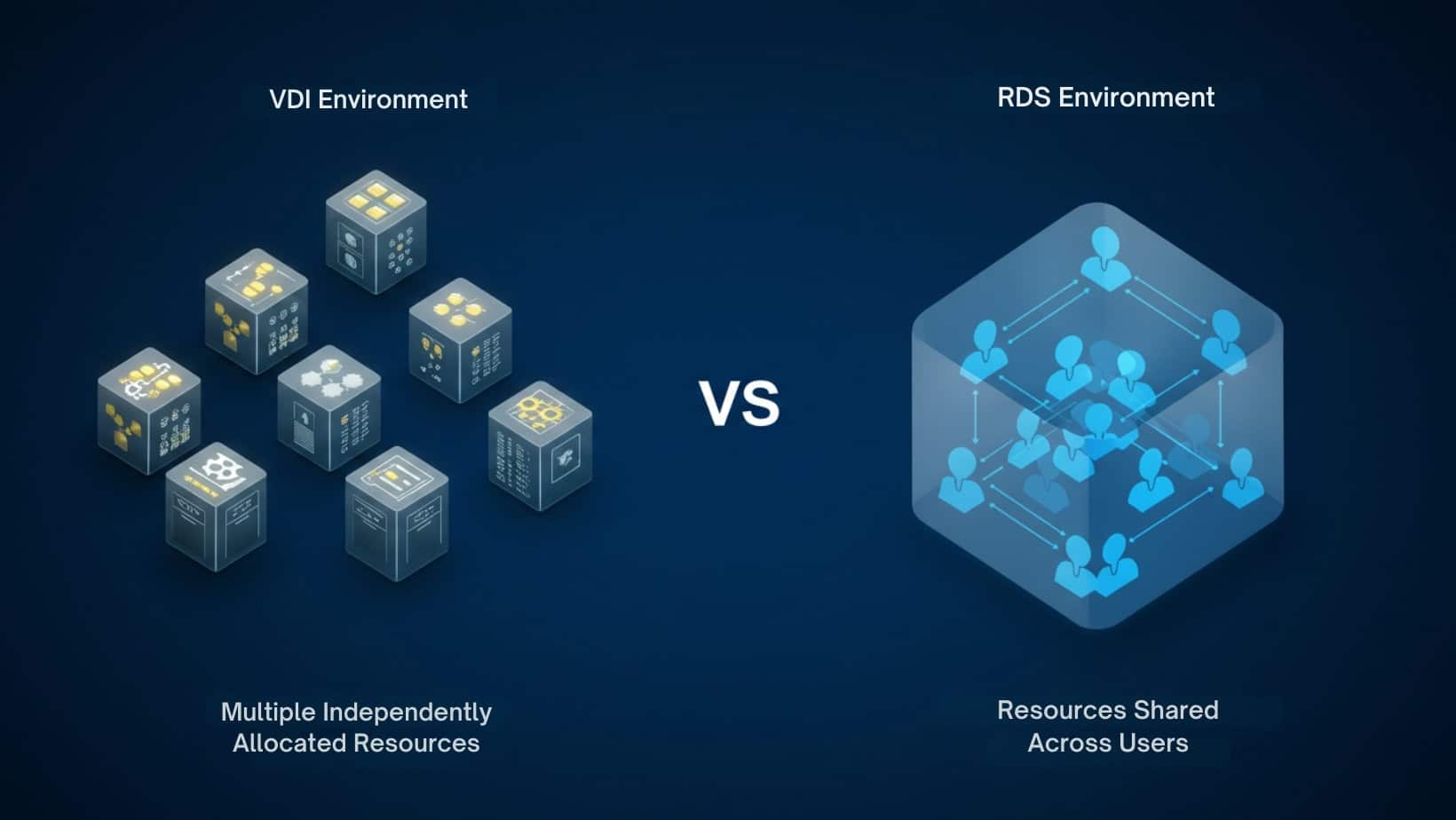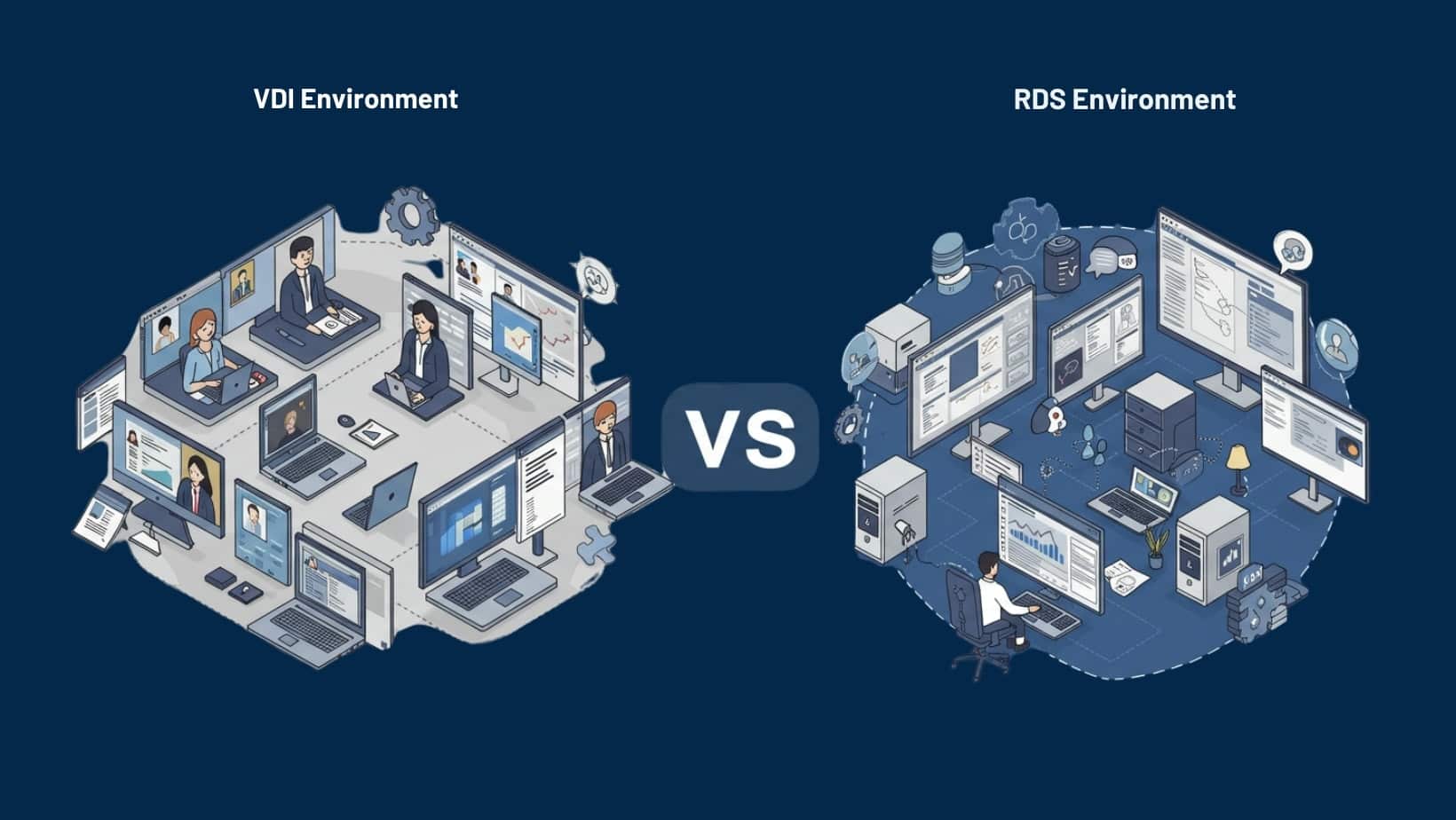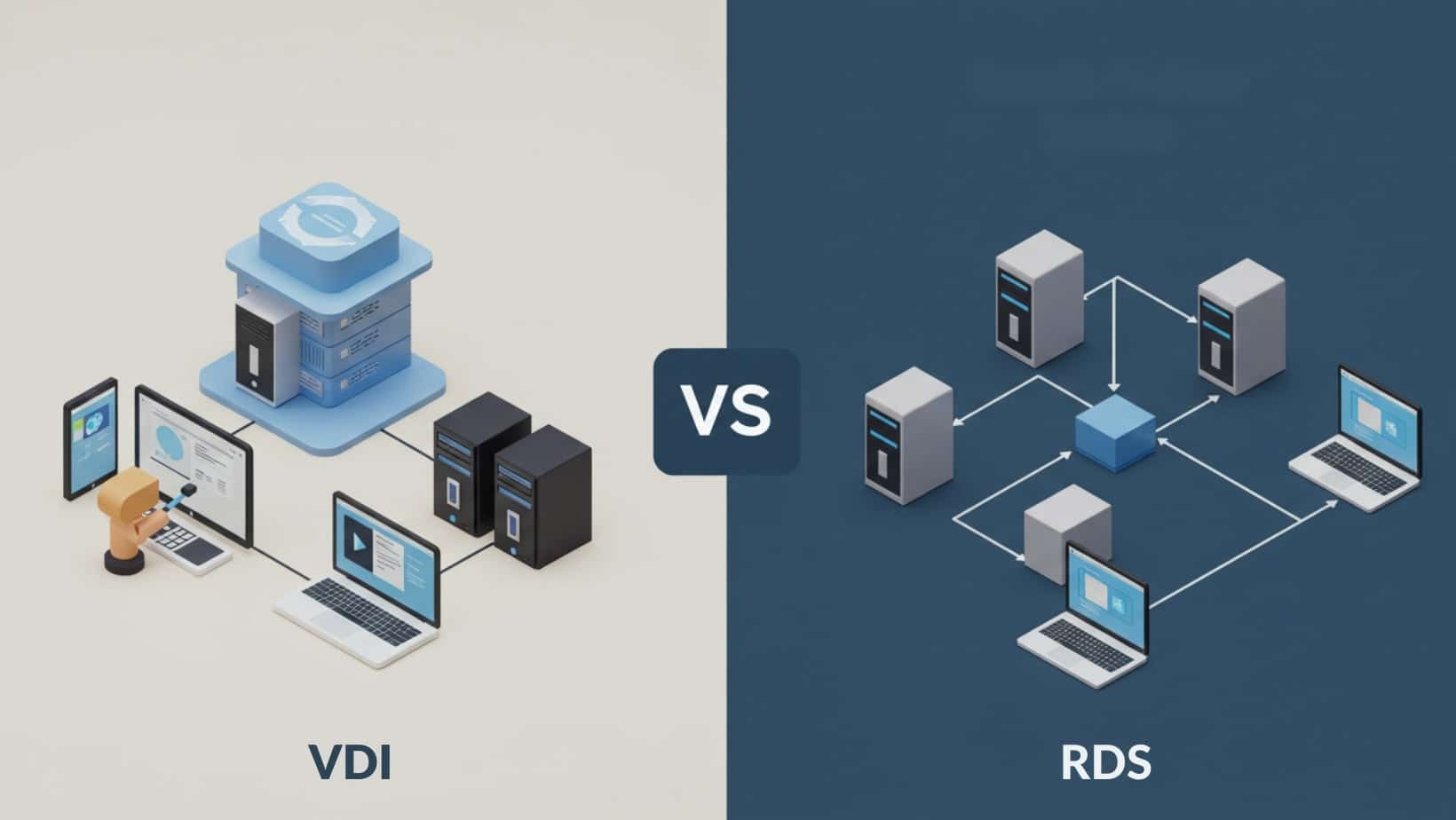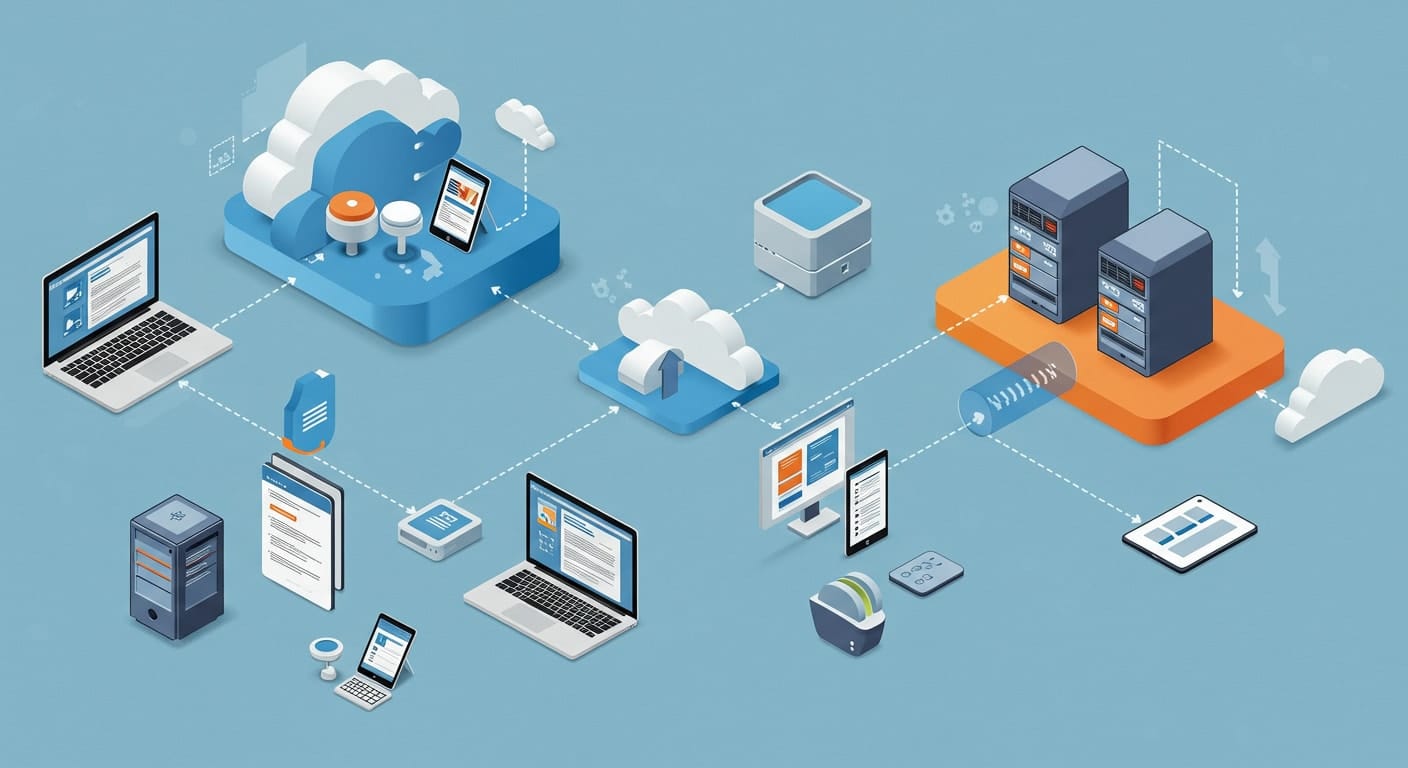Remote work isn’t just a trend anymore—it’s now how many companies operate daily. Chances are, your employees no longer rely solely on office desks and company computers.
Instead, they’re working from home or even halfway across the world, using their own laptops and phones. To make this possible, your business needs a reliable way for people to safely access desktops, files, and software remotely.
That’s where Virtual Desktop Infrastructure (VDI) and Remote Desktop Services (RDS) come in. Both help your employees connect remotely, but they do it differently. Choosing the right solution matters because it affects how smoothly your team can work, how secure your company data stays, and how much money you’ll spend.
This guide breaks down the key differences between VDI and RDS. By understanding these options, you’ll confidently select the best remote desktop solution for your business. Let’s get started.
What are VDI and RDS? Key Definitions Explained
What is Virtual Desktop Infrastructure (VDI)?
Virtual Desktop Infrastructure (VDI) is a technology that gives each user their own virtual desktop, hosted on a central server. Think of VDI as providing each employee their own virtual computer—complete with a separate desktop, operating system, applications, and files.
Instead of storing information directly on your personal computer or laptop, everything is safely kept on servers at your office or in a data center. When you log in, you connect securely to your dedicated virtual workspace, which looks and feels just like your own device, even though it’s actually running remotely on company equipment.
What is Remote Desktop Service (RDS)?
Remote Desktop Services (RDS), previously called Terminal Services, lets multiple users share a single desktop environment hosted on one central server. Unlike VDI, everyone accessing RDS uses the same operating system and applications simultaneously.
You can think of RDS as a group workspace—users log in and share resources, applications, and the desktop experience. Your files and settings are stored centrally, meaning that maintenance or software updates apply immediately for all users.
While this simplifies management and reduces costs, it also means less customization for each user, since everyone accesses a common, shared environment rather than their own virtual machine.
How Do VDI and RDS Work?
Understanding VDI Infrastructure
VDI relies on virtual machines, each running a dedicated desktop operating system like Windows 10 or 11, specifically for individual users. Each virtual machine is like a separate computer that exists entirely on your central server or data center.
When users log in from their own devices, a connection broker—a tool that manages user login and security—authenticates them and then connects them directly to their personalized desktop. This desktop feels personal and familiar, just like a physical computer, but it runs remotely.
The central piece, called the VDI server, uses virtualization software to create, manage, and monitor these individual virtual machines. This means administrators can quickly add new virtual desktops, assign them to users, or even reset them instantly if problems occur.
It’s powerful because users get customized desktops, while IT teams maintain total control over software, security, and updates from a single location.
Understanding Remote Desktop Services (RDS)
With Remote Desktop Services (RDS), multiple users share one common Windows Server environment hosted on a central server known as a Remote Desktop Session Host. Rather than giving each person their own virtual desktop, RDS lets everyone log into the same server environment at the same time, accessing applications and resources together.
A key component, the Remote Desktop Connection Broker, manages user connections efficiently, ensuring that each person connects smoothly to their shared sessions. It balances the load, directing traffic between different servers if your company uses more than one.
Historically, these servers were called terminal servers, and they centralize everything, making maintenance easier. For example, software updates, security patches, and general maintenance are handled once on the central server and instantly affect all users. Although users have less personalization, it streamlines administration significantly, saving your IT team time and effort.
VDI vs RDS: A Detailed Breakdown
1. User Experience and Personalization
When considering user experience, VDI offers a personalized feel similar to using your own computer. Each employee gets their own isolated virtual desktop, fully customizable and tailored to individual preferences.
It’s like having your own workspace, just stored remotely. Users can install personalized applications or adjust settings without affecting coworkers, resulting in a more dynamic and comfortable working environment.
RDS, on the other hand, provides a shared experience. Everyone logs into the same system and shares a common desktop and applications. Personalization is limited because changes by one user would affect everyone.
While this approach might seem restrictive, it simplifies updates and ensures consistency, ideal if your employees perform similar tasks and use identical applications regularly.
2. Resource Allocation and Computing Power
VDI needs significant server power. Because each virtual desktop runs independently—like separate computers on one powerful machine—it requires dedicated CPU, memory, and storage space.
This setup means your business needs stronger servers, potentially raising infrastructure costs. However, the advantage is clear: each user enjoys stable, predictable performance without interruption or slowdown caused by others.
In contrast, RDS efficiently shares computing resources among many users simultaneously. Instead of assigning dedicated resources per user, it pools server capacity and distributes it as needed.
This is especially beneficial for workloads that aren’t overly resource-intensive, like general administrative tasks or basic office applications. It saves resources and money by maximizing the server’s overall usage.
3. Cost-Effectiveness and Infrastructure Requirements
Initial costs for setting up VDI can be high. Your business needs robust hardware, virtualization software, and careful planning to support multiple isolated virtual desktops. Each user’s personalized desktop requires resources, and the more users you add, the more powerful and complex your infrastructure becomes.
Conversely, RDS is typically more budget-friendly, especially for smaller deployments or businesses with standardized tasks. It requires fewer resources since multiple users share the same desktop environment.
This centralized approach reduces hardware expenses, software licenses, and administrative overhead—particularly beneficial if your budget is limited or if you’re managing fewer employees with straightforward computing needs.
4. Scalability and Handling Seasonal or Dynamic Demands
If your business faces fluctuating user numbers—such as seasonal hires or temporary contractors—VDI excels. Adding or removing virtual desktops is straightforward, allowing rapid adjustment of resources as your business needs evolve. It offers flexibility and agility, essential for companies dealing with dynamic demands.
On the other side, RDS works best for predictable user numbers. It efficiently supports consistent user loads, but quickly scaling up or down can be challenging.
Sudden increases in user demand might impact performance because shared resources can become strained, making RDS less suitable for rapidly changing workforce sizes.
5. Security and Data Management
Security-wise, VDI stands out because each user’s desktop is isolated. If one user’s desktop gets compromised, others remain safe, reducing overall risks. All data is stored remotely, significantly reducing the potential dangers associated with user devices being lost or stolen.
With RDS, security management remains centralized, simplifying updates and monitoring. However, because multiple users share one environment, a security breach or misconfiguration could potentially expose multiple accounts simultaneously. Ensuring secure configurations and proper management practices becomes essential for maintaining strong security standards.
Overall, both solutions have strengths and trade-offs. Deciding between VDI and RDS hinges on understanding your organization’s specific needs around user experience, computing resources, cost, scalability, and security.
Practical Applications: Choosing VDI or RDS Based on Your Needs
When to Choose VDI
VDI is ideal when your team needs highly personalized and isolated desktop sessions. If your employees require unique software installations or customized desktops for intensive tasks—like graphic design, engineering, or software development—VDI meets those demands perfectly. It provides each person their own virtual workspace, delivering reliable computing power without performance issues caused by others.
Additionally, VDI excels in workplaces with changing demands, such as companies hiring seasonal employees or supporting remote workers across different locations. Because it’s flexible, you can quickly add or remove virtual desktops whenever needed.
This adaptability makes VDI a great choice for businesses looking for maximum customization and scalability, even if it involves higher initial investment and more complex infrastructure.
When to Choose RDS
RDS suits environments where users perform similar tasks and require identical software. It’s especially useful in scenarios like call centers, administrative roles, or any workspace where consistency matters more than personalization. Everyone shares one environment, streamlining updates and ensuring uniformity.
If your organization has a limited budget or prefers minimal maintenance, RDS is the smarter option. It requires fewer resources, reducing both upfront infrastructure costs and ongoing management expenses.
Additionally, RDS works best when your workforce size stays relatively stable, as it doesn’t easily scale to rapid changes. In short, if your business prioritizes cost-efficiency, simplicity, and a predictable environment where every user accesses similar tools and configurations, RDS fits your needs better than VDI.
Evaluating Performance: Internet Connection and Remote Access Considerations
Whether you choose VDI or RDS, a reliable internet connection is critical. Both technologies rely on stable connectivity since users access desktops remotely. Even minor disruptions can significantly affect productivity and user experience.
VDI typically requires stronger bandwidth because each user connects to a personalized virtual desktop, which may transmit richer graphics or more data-intensive applications. If your internet is slow or unstable, VDI sessions may lag, causing noticeable delays or interruptions, making tasks frustratingly slow.
RDS usually handles slower connections a bit better, as it sends less data—everyone shares a streamlined desktop with simpler graphics and applications. While RDS is somewhat more forgiving, an unreliable connection still causes issues like delays or dropped sessions, impacting efficiency and user satisfaction.
In short, ensure your team’s connectivity is robust. Reliable internet directly influences whether VDI or RDS can deliver a seamless, frustration-free remote experience.
Integration and Compatibility: Windows Server and Beyond
Both VDI and RDS integrate smoothly with various versions of Microsoft Windows Server, making them practical for nearly any existing IT setup. They’re compatible with Windows-based client operating systems, personal computers, laptops, thin clients, or even employees’ own devices, ensuring flexibility regardless of your team’s hardware choices.
VDI generally provides broader support for integrating into hybrid or cloud environments, allowing your business to extend resources easily between on-premises infrastructure and cloud services. RDS integrates seamlessly into traditional Windows Server setups, offering straightforward deployment but fewer hybrid options. Understanding your current IT landscape helps you select the option that aligns best.
VDI vs RDS: Frequently Asked Questions (FAQs)
- Can VDI and RDS coexist within the same infrastructure?
Yes, VDI and RDS can coexist smoothly in one infrastructure. Many businesses combine both solutions to meet diverse employee needs—using VDI for specialized tasks and RDS for general roles.
- Which provides better security: VDI vs RDS?
VDI typically offers stronger security since each desktop is isolated, reducing risk from compromised user sessions. RDS can also be secure but requires careful setup to protect shared environments.
- Do I need special software or a specific client device?
Generally, no special hardware is needed. Both solutions support standard devices—PCs, laptops, tablets, and thin clients. Users usually connect via built-in software or simple apps.
- How does each solution affect licensing costs?
VDI often has higher licensing and infrastructure costs, needing separate licenses for each desktop. RDS is usually cheaper, requiring fewer licenses because multiple users share one environment.
Conclusion: Choosing the Right Virtual Desktop Solution for You
Choosing between VDI and RDS ultimately depends on your organization’s specific needs—whether it’s personalized desktops, cost-efficiency, scalability, or security. VDI provides personalized, robust computing power, ideal for intensive workloads and dynamic teams, while RDS suits simpler, cost-sensitive, and standardized setups.
If you’re looking for a flexible and powerful solution to deliver exceptional remote experiences, try Apporto. With Apporto, you effortlessly access secure, scalable, and high-performance virtual desktops tailored to your business. Ready to experience seamless remote productivity? Give Apporto a try today and see firsthand why it’s the ideal virtual desktop solution for your team.

